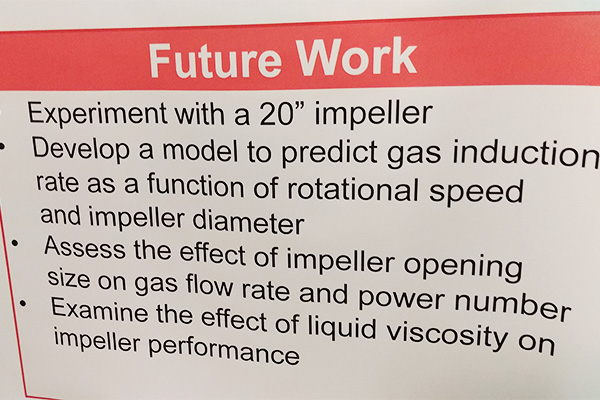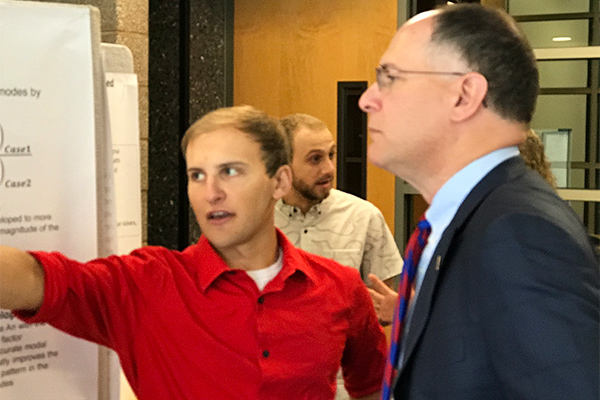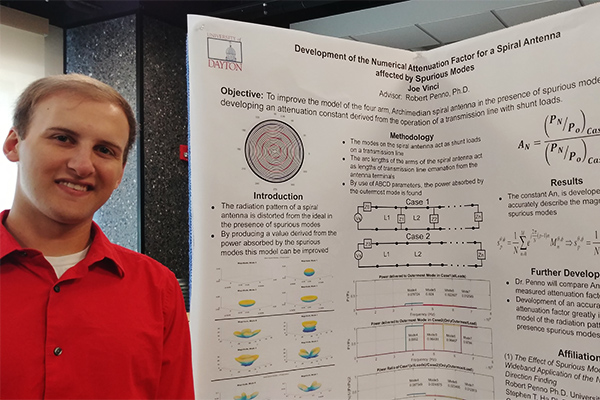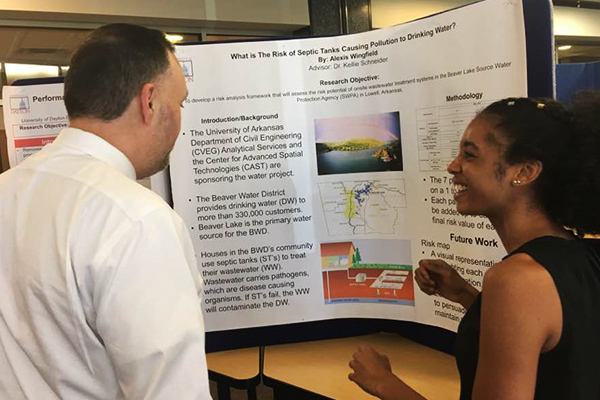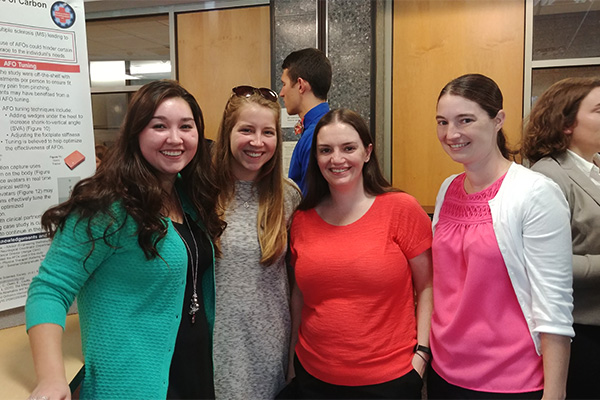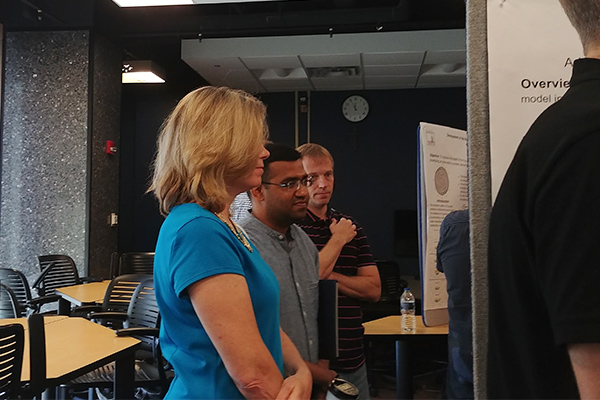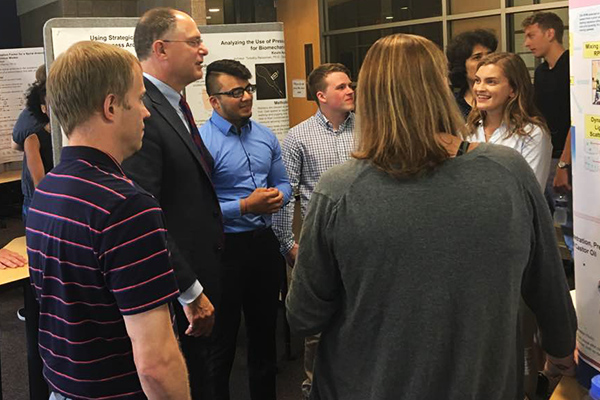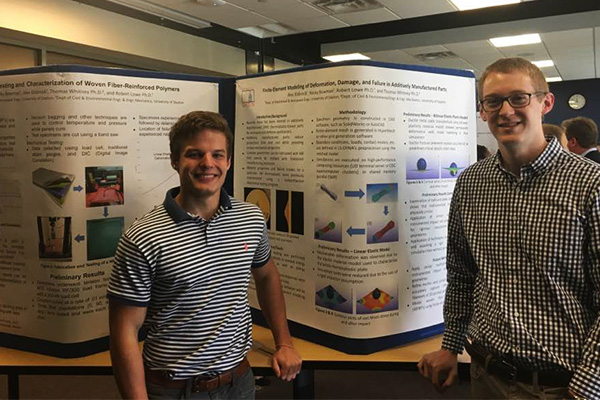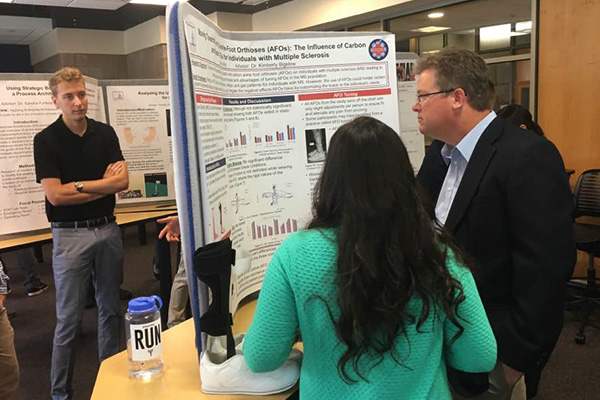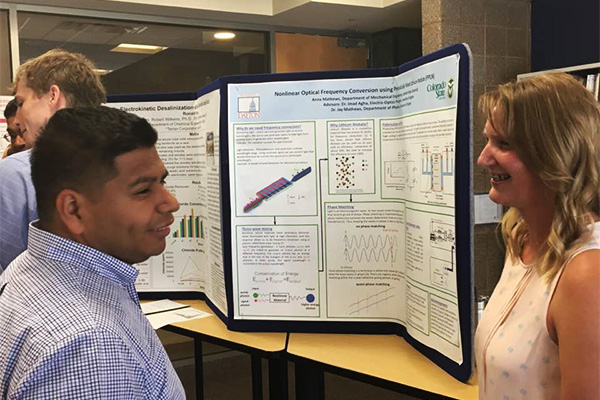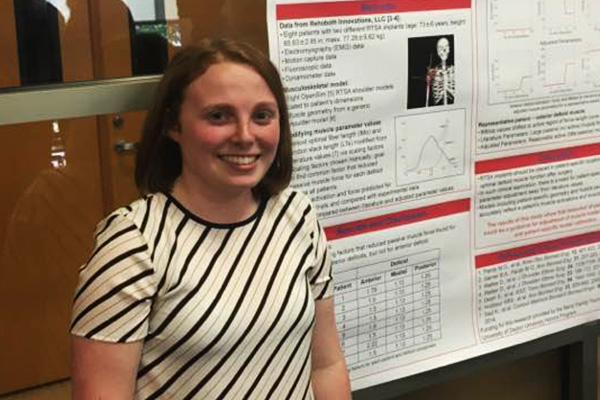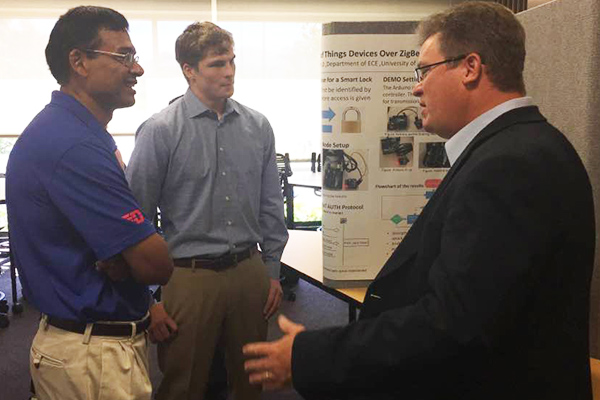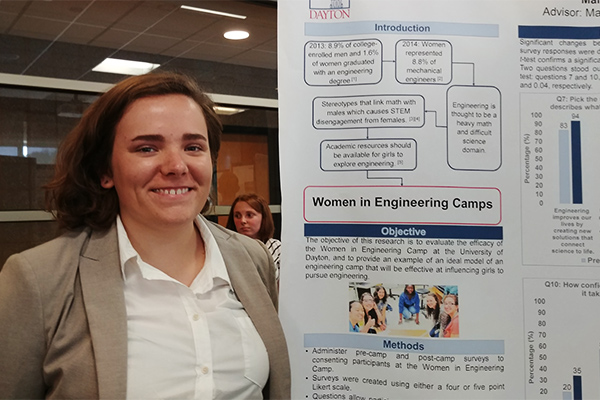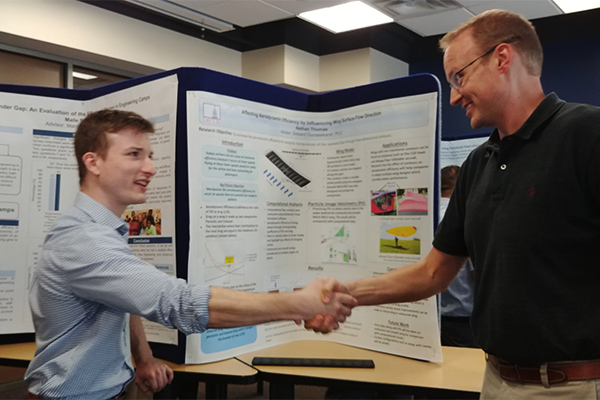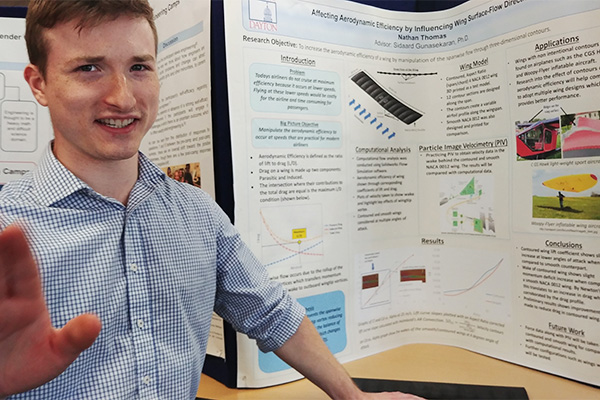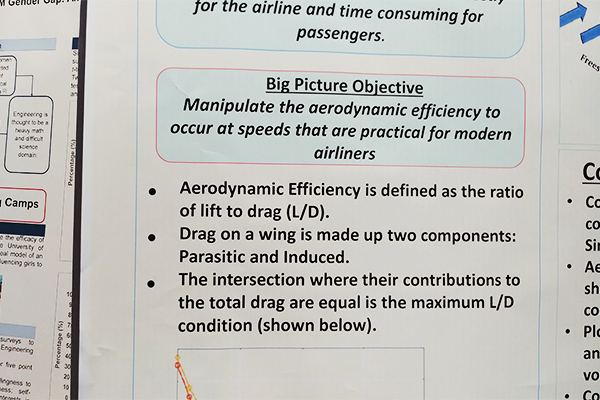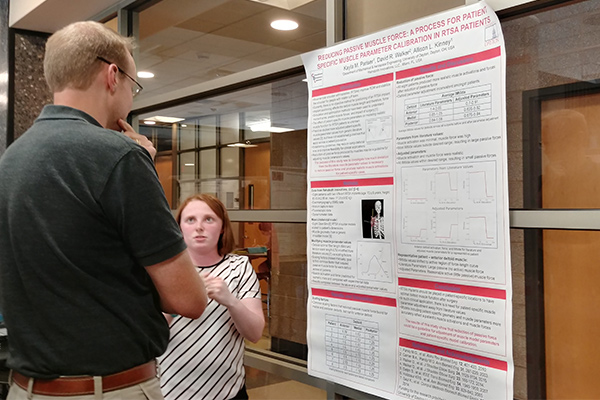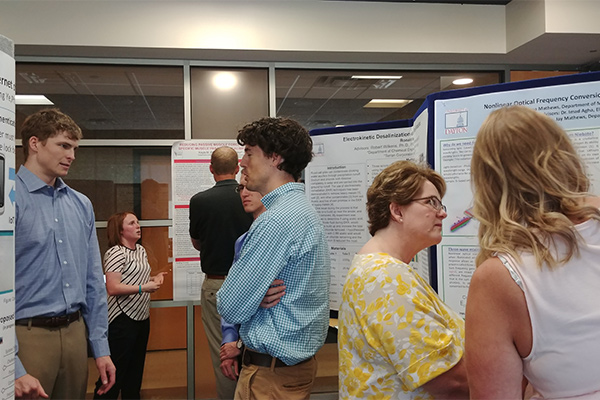Dayton Engineer
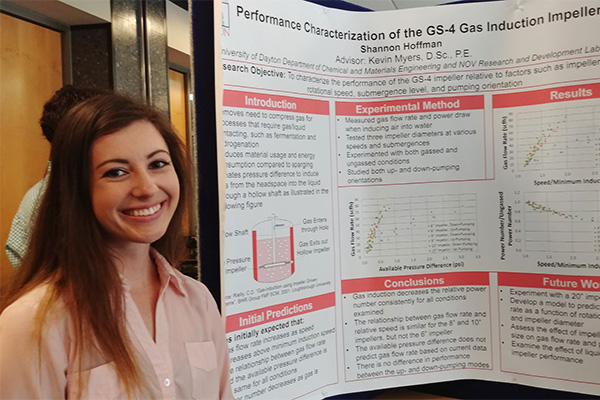
S.U.R.E.: Let's be real, life decisions are hard.
By Karen Updyke, School of Engineering
The second annual event, S.U.R.E. 2017, culminated in a successful poster session held on July 26 at the School’s Innovation Center.
The well-attended event enjoyed the support of UD leadership: President Spina, Dean Rojas, faculty, staff and students explored S.U.R.E. posters presented by undergraduate engineering student researchers.
Through S.U.R.E., grants and faculty mentors provide immeasurable assistance to undergraduate engineering and engineering technology majors, so they can pursue research in their areas of interest.
S.U.R.E. is a highly competitive program where students work on faculty-led research for 10 weeks at the University. Selected students receive a $5000 fellowship award for participating and may apply for an additional $1000 for travel expenses to present findings at a conference.
Dr. Robert Penno, electrical and computer engineering professor, was a first time S.U.R.E. mentor and worked with undergraduate student Joe Vinci. Penno was enthusiastically impressed with his research student and said, “Joe helped move the research forward and altered his perspective about post graduate research. He is now actively exploring graduate school options.”
About S.U.R.E., Penno explained, “The funding by Dean Rojas was more than adequate, and the involvement of leadership was remarkable with the dean, President Spina and numerous faculty attending the poster session. Their presence spoke to the importance of S.U.R.E. as a rewarding undergraduate experiential learning option where students perform important research work."
Shannon Hoffman, senior chemical engineering major, worked with Dr. Kevin Myers, chemical engineering professor this summer. They explored "a different approach to mixing,” said Hoffman. The S.U.R.E. program helped her decide on a research path after graduation. According to Hoffman, "S.U.R.E. was a great experience . . . a pure research experience. Let’s be real . . . life decisions are hard and this helped in my decision-making.”
Luke Schepers, junior mechanical engineering major, worked with Drs. Andrew Murray and David Perkins to validate and track human center of mass, and said, “Our project will benefit Dr. Kim Bigelow’s biomechanical group, and their group will be able to use our research effectively at the Engineering Wellness Through Biomechanics Lab.”
Malle Schilling, senior mechanical engineering major, said that her S.U.R.E. research grant with Dr. Margie Pinnell, The STEM Gender Gap: An Evaluation of the Efficacy of Women Engineering Camps, was successful and “may lead to her honors thesis.”
Nathan Thomas, junior mechanical engineering major, and mechanical engineering professor, Dr. Sidaard Gunasekaran, investigated aerodynamic efficiency. “Preliminary results show improvements can be made to reduce drag in contoured wings,” said Thomas. Excited about this research in his area of interest, Thomas said that he’d like to “build on the knowledge gained this summer” during the upcoming academic year.
James Althoff, senior computer engineering major, found his research direction in cyber security with computer engineering professor, Dr. Feng Ye. Althoff discovered S.U.R.E. through an email last December and pursued the grant because of his interest in the Internet of Things. Althoff said that he benefited not only from “relevant topic information” but also from useful “how to research a topic” discussions with Dr. Ye — an added bonus.
Ron Knapp, junior chemical engineering major, Dr. Bob Wilkens, chemical and materials professor and Christopher Athmer, Terran Corporation, explored “removal of chloride from soil.” Knapp said that the S.U.R.E. program “was a good way to learn and helped me to decide to pursue the environmental aspect of engineering."
This summer S.U.R.E. welcomed two undergraduate students from other universities: Connor Evans, bioengineering major from Duquesne University, worked with chemical engineering professor, Dr. Erick Vasquez; and Anna Mathews, mechanical engineering major from Colorado State University, worked with electro-optics professors, Drs. Imad Agha and Jay Mathews.
Evans discovered S.U.R.E. through an online search. According to Evans, “The S.U.R.E. coordinators were very welcoming, and it was an easy application process — a rewarding experience.” Because of S.U.R.E., Evans is considering grad school at the University of Dayton.
S.U.R.E. 2017
| Faculty Mentor | Undergraduate Students | Research |
| Sidaard Gunasekaran, Ph.D. | Nathan Thomas | Affecting aerodynamic efficiency by influencing wing surface-flow direction |
| Sandra Furterer, Ph.D. | Baxter Rechtin | Using strategic business process architecture models to create
a process architecture reference for the healthcare industry |
| Erick S. Vasquez, Ph.D. |
Connor J. Evans, Duquesne University and Hannah E. Sims |
Separation of aqueous ethanol mixtures from castor oil |
| Kristen K. Comfort, Ph.D. | Cameron Crasto, Maggie Jewett and Jacob Reynolds | Combinatorial silver nanoparticle and hypoxic exposure on lung cells |
| Robert Lowe, Ph.D. and Thomas Whitney, Ph.D. | Alex Elsbrock and Rocky Bowman | Finite-element modeling of deformation, damage and failure in additively manufactured parts |
| Andrew Murray, Ph.D. and David Myszka, Ph.D. | Joseph Raffoul | Characterization of power consumption in servo motors in controlled motions |
| Kimberly Bigelow, Ph.D. | Sarah Hollis | Moving towards tuning of ankle-foot orthoses (AFOs): The influence of carbon and plastic AFOS for individuals with multiple sclerosis |
| Timothy Reissman, Ph.D. | Kevin Nowacki | Analyzing the use of pressure sensing shoe insoles for biomechanical research |
| Allison L. Kinney, Ph.D. and David R. Walker, Rehoboth Innovations, LLC, Miami, FL, USA | Kayla M. Pariser | Reducing passive muscle force: A process for patient specific muscle parameter calibration in RTSA patients |
| Robert Wilkens, Ph.D., P.E. and Christopher Athmer, P.E., Terran Corporation, Beavercreek, OH | Ronald Knapp | Electrokinetic desalinization of kaolin soil with acetic acid |
| Margaret Pinnell, Ph.D. | Malle Schilling | The STEM gender gap: An evaluation of the efficacy of women in engineering camps |
| Andrew Murray, Ph.D. and David Perkins, Ph.D. | Luke Schepers | Validating the location and tracking of a human's center of mass using a statically equivalent serial chain |
| Kevin Myers, D.Sc., P.E. | Shannon Hoffman | Performance characterization of the GS-4 gas induction impeller |
| Feng Ye, Ph.D. | James Althoff | Authentication of the Internet of Things devices over ZigBee networks |
| Robert Penno, Ph.D. | Joe Vinci | Development of the numerical attenuation factor for a spiral antenna affected by spurious modes |
| Imad Agha, Ph.D. and Jay Mathews, Ph.D. | Anna Mathews, Colorado State University | Nonlinear optical frequency conversion using periodically poled lithium niobate (PPLN) |
| Kellie Schneider, Ph.D. | Alexis Wingfield | What is the risk of septic tanks causing pollution to drinking water? |

